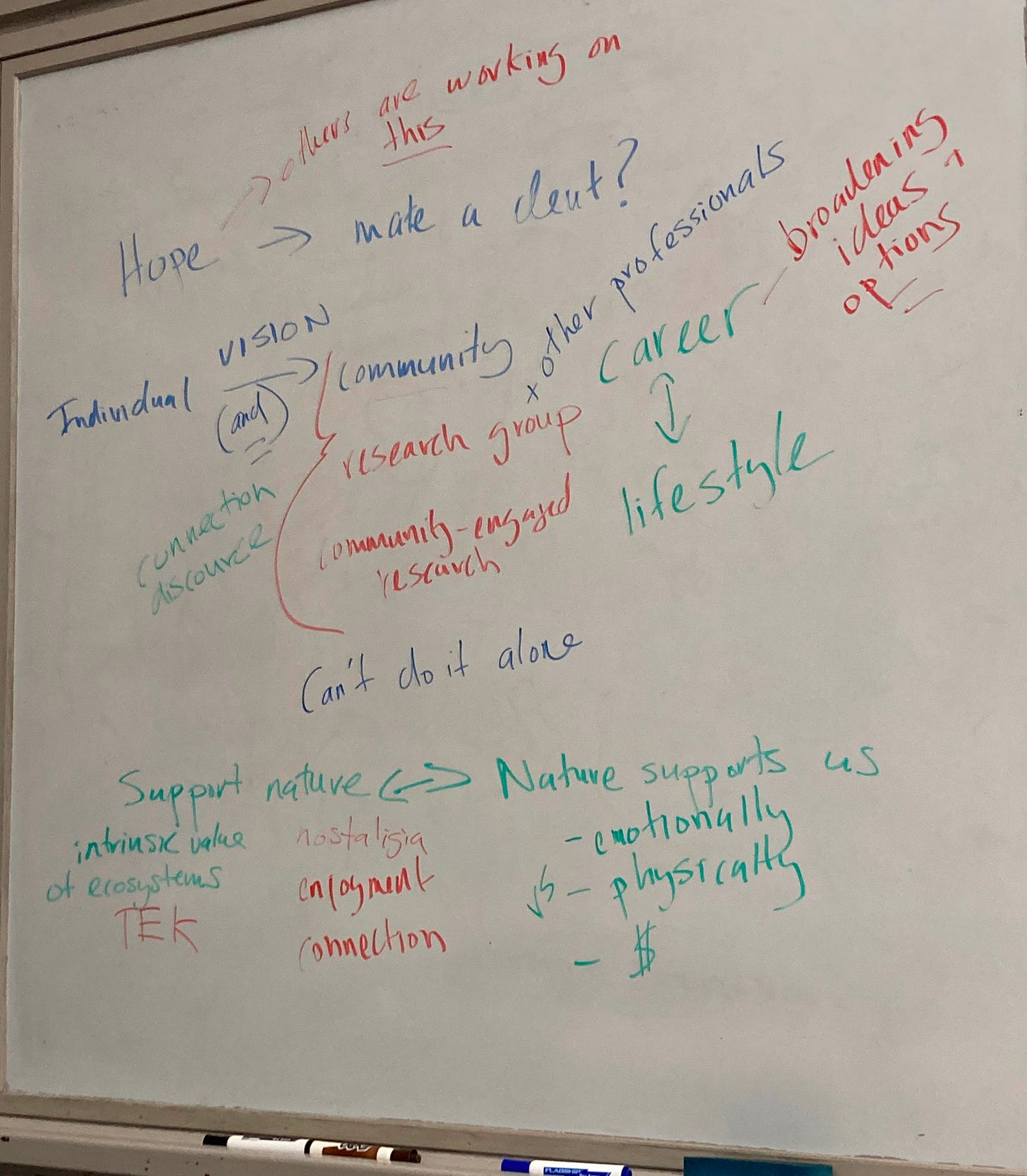Should “hope” be a university course learning outcome?
And what role is there for AI in education?
Another semester is coming to a close this week here in Maine. While graduates are celebrating (or crying or wondering what they will do next…), I’ve been thinking about the role of university classes in students’ lives. I taught just a bit this last year, co-instructing a seminar course called "Seminar in Sustainability Solutions". It's a mixed undergraduate and graduate class in which students primarily listen to talks from invited speakers.
At the end of each semester, we asked the students what they had learned. We also asked how their ideas about sustainability, and their role in "sustainable futures" may have changed.
I didn’t really know what to expect. The speakers had covered such a wide range of topics. What would the students walk away with? This photo below shows a picture of the whiteboard where I was writing up their responses last semester.
There are two themes that I was excited about here.
The first is one of community, working together, and the realization that any work that they do individually is part of something bigger.
The second is that they draw hope from the idea that there are others who are thinking about or working on these challenges.
Students in the spring semester brought up some of these same ideas, and added concepts such as the importance of community engagement in research, and the fact that there are many different “communities”, and many unique individual stories within those communities, that we could and should pay attention to.
Their ideas led my co-instructor, David Hart (who developed the course), and I to discuss the role of university instruction in such big picture and abstract concepts as fostering hope or feeling connected. Should “hope” be a course "learning outcome"? Is this more or less important than the more concrete information and skills that students obtain through their more traditional courses?
I think the posts shared last week by students at North Carolina State show off some real concrete scientific learning (i.e the multiple benefits of specific cover crop choices from Meg Sandy), as well as some more abstract and emotive outcomes that cross over with the ones from our seminar class (i.e the power of creating community from Jaleel Hewitt).
I know that we need both of these types of learning. But this experience has reminded me that these bigger picture themes can be imparted through teaching. In fact, it is the general "feeling" of certain classes, rather than the equations or theories, that I remember most clearly from my time as an undergraduate many years ago. What do you remember the most clearly?
I also wanted to create a visual to help me process this idea. But, I’m far from a talented artist. I wondered, could I use a generative AI tool to help? You may not think this is a particularly productive thing to do. Maybe it's not. But it felt appropriate because it is part of something else I’ve been reflecting on after this year of instruction. Students now have the opportunity to use AI tools more than ever before. In fact, we had to create an AI-use policy for this course between the fall and spring semesters (ask if you want to know what we ended up with).
So, as we sort through how to integrate AI tools into education (and so many other things), here I experiment with some of these tools, in an attempt to illustrate the outcomes of course.
First, I used the software Canva, and their AI tool called Magic Studio™. I asked it to create a visual for me which "showed university students learning that we all have to work together for a sustainable future". The image here is one of the few that it created:
Next, I tried ChatGPT. I asked it the same question, and also suggested it could incorporate some of the ideas that the students had raised, such as “community”, “relationships”, etc. I went through a few iterative rounds, and landed on this:
Neither are exactly awe-inspiring. (And I could not find a way to get the model to put the students in any more interesting clothing. The second time I asked, it just gave another person stripes, which I thought was hilarious.)
But I’m ok with AI learning models being less good at this than a person, at least so far. What I felt was really missing was the way that good art can capture a feeling. Or…inspire a feeling. I finally decided to ask ChatGPT to “create abstract art that just shows the idea of collective hope”. And it generated this:
That one I quite like? It at least come closer to showing what I think the students were describing. Thoughts? Like it? Not so much? Could you create something more interesting?
I hope some of the thousands of students graduating this month are taking some feeling of hope, and community, and collective efficacy with them. If they are, that makes me feel a bit more hopeful myself.










Beautiful, Sara. I would like to think 'hope' is something students leave the classroom with--and certainly telling them 'agroecology was not a major at NC State and now it is' as proof of progress and their interest to make change of their agency. But should hope be a learning objective? No, not explicitly. It could be a latent outcome as compared with a manifest (i.e., measurable) outcome. Partly for the reason that hope is more perceived and constructed by the attendees. Maybe 'hope' is a teaching aspiration......